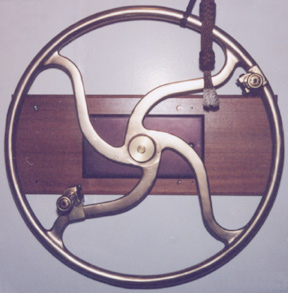S-37
| Other Names: SS-142/Imperial Beach Submarine | Date of Sinking: February 20, 1945 | |||
| Rig/Type: S-1 Class Submarine | Cause of Sinking: To be used as a target, but it broke tow and sank | |||
| Length: 219' 3" | Breadth: 20' 8" | Tons: 854/1062 | Cargo: None | |
| Built: 1919 by the Union Iron Works of San Francisco | Location: Off Imperial Beach, Calif. | |||
| Hull Construction: Steel | Depth: 30' | Visibility: 0-30' | ||
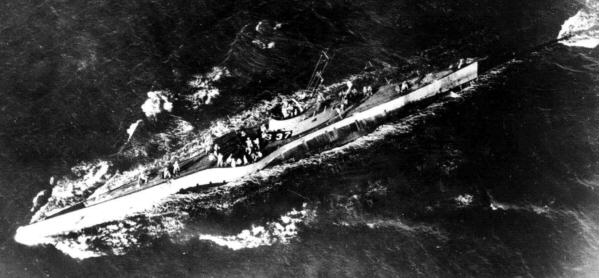
The S-37 Underway
S-37 (SS-142) was laid down on December 12, 1918 by the Union Iron Works, San Francisco and launched on June 20, 1919. However, by the time of her launch, the first world war was long over and it wasn't until July 16, 1923 that she received her first commission. She carried a crew of 42 and was armed with one 4" deck gun and four 21" torpedo tubes.
After fitting out at Mare Island, she departed San Francisco and joined Submarine Division 17 at San Pedro on August 1 and conducted exercises off the coast of Southern California. On 10 October, she was badly damaged by an explosion in the after battery compartment which killed three crew men. The S-37 returned to Mare Island for repairs and by mid-December, returned to San Pedro. After transiting the Panama Canal and conducting exercises in the Caribbean, she returned to San Francisco to prepare to cross the Pacific. After a short stop at Pearl Harbor, the S-37 reached Manila Bay on November 4. For the next 16 years, the S-37 and the rest of SubDiv 17 worked out of the harbor of Cavite in the Philippines.
On December 8 1941 (Philippine Time), the Japanese attacked Pearl Harbor, prompting her to venture out on her first war patrol the next day. She was assigned to patrol the Philippine Islands and latter Java in the following months.
On February 8, she sighted a destroyer, but waited for the protected transport ships. Moving on the surface, she closed in on the four destroyers, running in column some 8,000 yards distant. All torpedoes were loaded and she began her attack run when the outlines of three large transports were seen on the horizon. Due to the slow speed of the S-37, she was unable to catch up with the transports and focused back on the destroyers. Firing one torpedo at each of the four destroyers, one found its mark, blowing the Natsushio in two. The remaining destroyers then turned to attack the sub, dropping depth charges in the area.
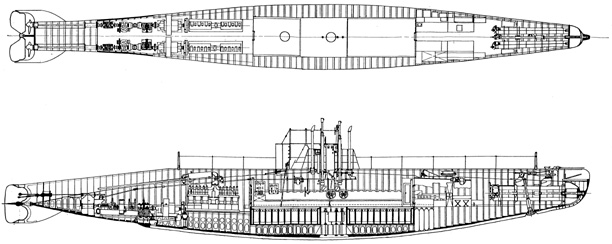
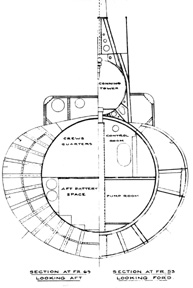
Deck, Profile and midship drawings of the S-37.
By now the submarine was 23 years old--older than many of its crew and was showing its age. Not only was it slow, it was plagued with many problems, including a leak that left a mile-long oil slick in its wake. This black arrow on the surface lead to many depth charges being dropped, compounding the condition of worn parts and equipment and resulting in mechanical and electrical failures and leaks through disintegrating manhole and hatch gaskets. On March 6, she headed for western Australia. By then the major leak, through the engine room hatch, had been slowed to one gallon every 20 minutes.
A junior officer on the S-37 wrote this graphic account: The bunks beyond the wardroom are filled with torrid, skivy clad bodies, the sweat running off the white, rash blistered skin in small rivulets. Metal fans are whirring everywhere overhead, and at the end of the bunks, close to my ear, I am playing cribbage with the skipper, mainly because I don’t like to wallow in a sweat soaked bunk most of the day. I have my elbows on the table near the edge and I hold my cards with my arms at a slight angle so the sweat will stream down my bare arms, without soaking the pile of cards in the center. Overhead is a fine net of gauze to catch the wayward cockroaches, which prowl across the top of the wardroom and occasionally fall straight down. They live in the cork insulation, which lines the inside of the submarine itself. We’ve killed over sixteen million cockroaches in one compartment alone. The deck in the control room is littered with towels, used to sponge up the water dripping off the men and the submarine itself. The food is routine, something canned. The dehydrated potatoes, powdered onions, and reconstituted carrots have the same general taste; like sawdust.
On July 7, she shifted back to the New Britain coast to patrol in the Lambert Point area.
On the
afternoon of the eighth, she sighted a Japanese merchantman escorted by a submarine
chaser and fired three torpedoes, sinking the 2,776-ton Tenan Maru.
Shortly thereafter, another fire broke out on the 14th, compounding numerous
mechanical and electrical failures. On November 5, another fire in her port main motor added to
her problems, and she limped back to Pearl Harbor and finally, San Diego.
It was the end to the little submarine's fighting career, which earned the S-37 earned five battle stars.
During the winter of 1943, the S-37 underwent an extensive overhaul
and spent the remainder of her career in San Diego, employed as an antisubmarine warfare training ship
through 1944. Decommissioned on February 6 1945, the S-37 was stripped, and her hulk was
towed out to be sunk
off Imperial Beach on February 20, 1945 as a target for aerial bombing .
However, her tow broke and she sank coming to rest some 50-60' deep.
|
Above: The profile of an S-class submarine. |
 |
Diving the S-37
An attempt was made to salvage the S-37 by a private salvor several years ago. The sub was brought back to the surface and eventually beached, coming to rest in 20-30' of water off Imperial Beach where it remains today. Read an account of one of the salvors of its sale and salvage, generously donated by its author, Frank Ball. In 1980, it was relocated by the California Wreck Divers and dived ever since.
The S-37 lies almost 90 degrees to shoreline, with its bow nearly buried in the sand. It has a 20-30 degree list to port and the conning tower will break the surface at low tides or high surf. For many years, the growth on the hull was minimal and the details of the sub were easy to identify. However, after San Diego's sewer line broke about a decade ago, several inches of mussel shells have blanketed the wreck. Although the sewer pipe was fixed long ago, the mussels now feed on the outflow of the Tijuana River. Visibility on the wreck is usually poor due to its proximity to the surf line. The wreck is inaccessible from the shore and must be reached by boat.
Despite its shallow depth, the S-37 is very dangerous wreck to dive. As a true overhead environment, the S-37 should be dived in accordance to technical cave diving practices. The first thing a diver will notice when diving the S-37 is its small size--it appears to be more of a torpedo than a submarine. The outer tanks make up over a third of its 20' beam, leaving approximately 13' of habitable hull (see midship section drawing above). Add a foot or two of sand and you now have a very cramped area to penetrate. Inside the sub, the sand is actually a fine silt, and is easily disturbed despite the best attempts of staying off the bottom. Shortly after entering the hull, the visibility diminishes to zero, concealing all light and exits. The many lobster, sculpin and other rockfish that inhabit the wreck are easily disturbed by the presence of a diver. Equally as blind in the silted environment, they crash in to the diver making it a spooky dive.
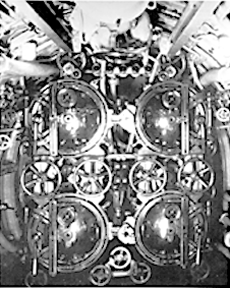 |
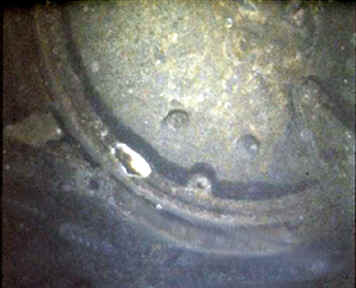 |
| Torpedo Tubes | One of the torpedo doors underwater. |
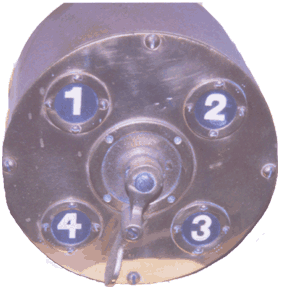 |
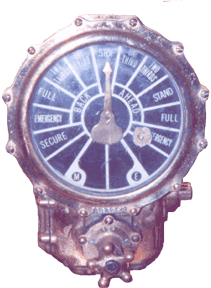 |
| Torpedo Tube Selector | Engine Telegraph |
|
|
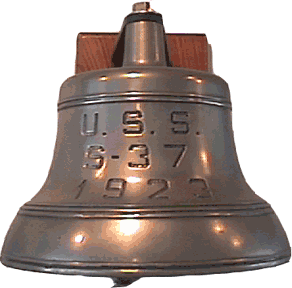 |
| A wheel from the S-37. | The S-37's bell on display at the San Diego Maritime Museum |
| Like to learn more about this wreck? Visit our Guest Page to submit your inquiry. |

